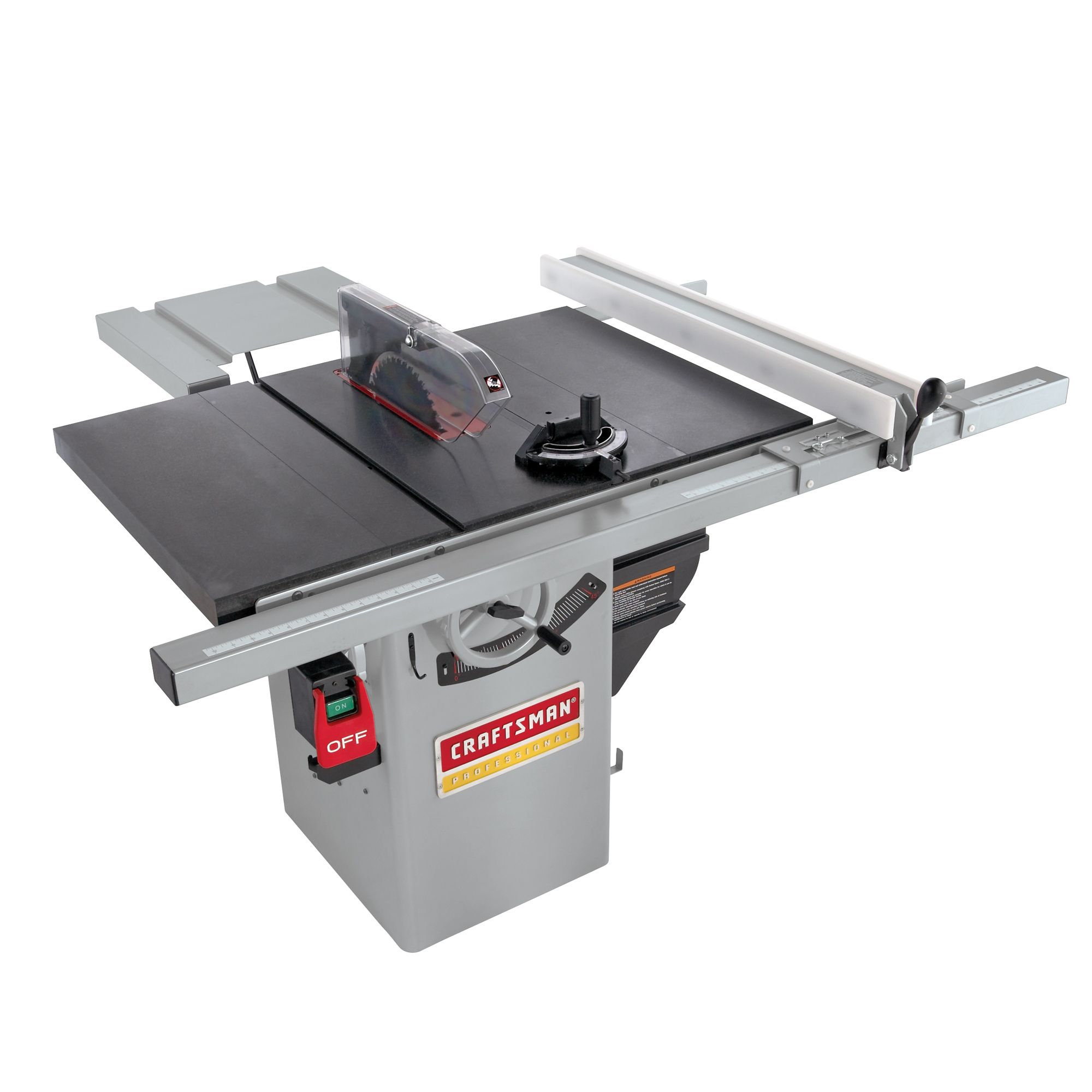Loading ...
Loading ...
Loading ...

The Craftsman stationary saw dado set maximum capacity is
% I.D.x 8" O.D. x _6" width.
IMPORTANT: Always use correct insert. When using the dado
set, use caution. Use featherboards and push sticks as applic-
able.
WARNING: Always immediately replace the standard blade,
blade guard and blade insert when you are finished dadoing.
CUTTING OVERSIZED WORKPIECES
When cutting long workpieces or large panels, always support
workpiece that is not on table. Use rear outfeed table exten-
sion or make simple support by clamping a piece of plywood
to saw horse. Add facings to miter gauge or rip fence as
needed.
IMPORTANT: Do not allow facings to interfere with operation
of blade guard.
DUST COLLECTING
• Saw is fitted with a 4" male exhaust port.
• Use of a dust collector is recommended.
• Be certain motor and internal mechanisms are clean and
are frequently vacuumed or blown free of any dirt.
LUBRICATION
All bearings on the arbor are shielded ball bearings. These
bearings are permanently lubricated at the factory.
• As needed, clean the grease off the rack and worm gears
of height and tilt mechanism. Lubricate rack and gears
with a medium viscosity machine oil.
• Be sure to lubricate trunnion ways and all bushings.
• Occasionally oil all other bearing points, including blade
guard assembly, miter gauge and rip fence.
SERVICE
• Replace belts and worn parts as needed. If power cords
are worn, cut, or damaged in any way, have them
replaced immediately.
• Make sure teeth of antikickback pawls are always sharp.
• Sharpen dull teeth using a few light strokes of a smooth
cut flat file.
BLADE SELECTION
Blade selection is based on type of material being cut and
how it will be cut. There are three general types of saw
blades: rip saw blades cut with grain of wood, cut-off saw
blades cut across grain, and combination saw blades cut with
grain, across grain and any angle to grain.
Blades vary in many aspects. When selecting a blade, the fol-
lowing blade characteristics should match up with operation to
be performed and type of material to be cut: type of steel;
quality of steel; tooth style; tooth set; carbide tipped; grind;
number of teeth and size.
IMPORTANT: Your saw is only as accurate and efficient as
blade or cutting tool used.
First, be certain to use the appropriate type of cutting tool for
the operation to be performed. Second, it is strongly recom-
mended that high-quality blades and cutting tools be used. Be
certain blades and cutting tools are kept sharp and in good
working order. Check blades periodically and replace or
sharpen if necessary.
WARNING: Do not attempt under any circumstances, to
service, repair, dismantle, or disassemble any mechanical
or electrical components without physically disconnecting all
power sources.
CLEANING
• Clean off any preservative on bright (machined) parts with
appropriate solvent (mineral spirits). Avoid getting cleaning
fluid on any rubber parts as they tend to deteriorate rub-
ber.
• Use soap and soft water on rubber and plastic parts.
• After cleaning, lubricate unpainted surfaces with a light
application of medium consistency machine oil. This lubri-
cation should be repeated at least once every six months.
• Use a damp cloth to clean the granite table.
• Keep your machine and your workshop clean. Do not allow
sawdust to accumulate on saw or inside cabinet.
Frequently vacuum or blow out any sawdust that may
accumulate within cabinet.
CHANGING THE SAW BLADE
Refer to Figures 7 and 8.
NOTE: Any replacement blades must have a body thickness
less than the thickness of the riving knife/splitter. The kerf
width (width of cut made by the blade) must be greater than
the thickness of the riving knife/splitter. Check markings on
riving knife/splitter and on blade or blade packaging.
WARNING: Turn the power switch "OFF" and unplug the
power cord from its power source when changing the saw
blade.
WARNING: USE ONLY 10" diameter blades with 5/8 arbor
holes, rated at or higher than 3800 R.P.M.
• Raise saw blade to maximum height.
• Remove the table insert retaining bolts and table insert
(Fig. 7, Key Nos. 13 and 14).
• Remove blade guard/splitter or riving knife (Fig. 7, Key
Nos. 25 and 40).
• Two wrenches are supplied with the saw (Fig. 8, Key Nos
66 and 67). Place open-end wrench on the flat of the
arbor (Fig. 8, No. 56). Place box wrench on the arbor nut
(Fig. 8, Key No. 59) and loosen nut. Remove nut, flange
and blade (Fig. 8, Key Nos. 57, 58 and 59).
• Place new blade on arbor. Make sure blade teeth points
down at the front side of blade. Place flange and nut on
arbor and securely snug blade in position.
• Replace blade guard/splitter or riving knife.
• Replace table insert and tighten the table insert retaining
bolts.
BACKLASH ADJUSTMENTS FOR BLADE
RAISING/LOWERING AND BLADE TILTING
ASSEMBLIES
Refer to Figure 8.
If any play is detected in the blade raising/lowering or blade
tilting assemblies, the following adjustments should be made.
WARNING: Make certain that the saw is disconnected from
the power source.
• To adjust blade raising/lowering assembly, loosen lock nut
(Key No. 22) and turn the eccentric sleeve (Key No. 36)
until all play is removed in the assembly, then tighten lock
nut.
13
Loading ...
Loading ...
Loading ...
